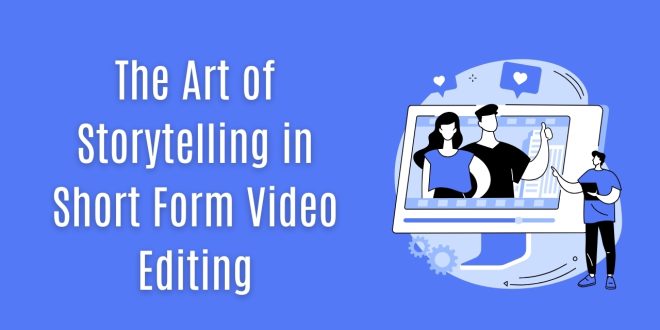In today’s fast-paced digital world, short-form videos have become the go-to format for entertainment, education, and engagement. Platforms like TikTok, Instagram Reels, and YouTube Shorts offer creators a canvas to tell compelling stories—often in under a minute. But how do you capture someone’s attention, convey a message, and evoke emotion in such a short span of time? The answer lies in mastering the art of storytelling. As a leading short form video editing agency, we understand the nuances of crafting impactful stories in short-form video editing that leave a lasting impression on your audience. Let’s explore how you can achieve this in your own projects.
Why Storytelling Matters in Short Form Videos
Capturing Attention in Seconds
With the average attention span shrinking by the year, creators only have a few seconds to hook their audience. This makes storytelling crucial because it gives viewers a reason to keep watching. A well-told story, even in a 30-second clip, can grab attention faster than random, disjointed content. Your goal is to draw viewers in right from the start, whether through suspense, intrigue, humor, or emotion.
Think about it: when you scroll through your social feed, what makes you stop? Often, it’s a strong narrative that promises something interesting—whether it’s the payoff of a joke, a clever plot twist, or an emotional moment.
The Emotional Connection
One of the most powerful aspects of storytelling is its ability to create emotional connections. Stories have the ability to evoke feelings of joy, sadness, excitement, or even nostalgia in just a few seconds. Emotional content is memorable, and it’s what keeps viewers coming back for more. Even with the limitations of short-form videos, you can weave emotions into your content through visuals, sound, and concise dialogue.
Key Elements of Effective Storytelling in Short Videos
Beginning, Middle, and End
Even in short-form content, having a clear structure is essential. Every story needs a beginning, middle, and end, no matter how short the video is. In the beginning, you introduce your characters or situation. The middle builds tension or intrigue, and the end delivers a resolution or punchline.
For instance, a popular storytelling format in TikTok is the “before-and-after” trend. The “before” sets the stage, often showing a problem or unfulfilled state, and the “after” shows the resolution, whether it’s a makeover, a solution, or a surprise twist.
Defining Your Message
Short videos don’t leave room for unnecessary details, so your message needs to be crystal clear. Ask yourself, “What’s the one takeaway I want my audience to remember?” Having a focused message helps ensure your video is both concise and impactful. It also ensures your story doesn’t get lost in the rush to fit everything into a short clip.
Visual Storytelling Techniques for Short Form Content
Using Cinematic Shots
The way you frame your shots can dramatically change how your story is perceived. Even in short videos, you can create a cinematic feel by carefully considering composition, lighting, and camera angles. Wide shots, close-ups, and perspective shifts can all be used to enhance the story you’re telling. Experiment with visual composition to add depth to your video, such as placing your subject off-center to evoke curiosity or tension.
The Power of Visual Metaphors
In short videos, you may not have the luxury of long explanations. This is where visual metaphors come in. Using symbols, gestures, or imagery can quickly convey complex ideas or emotions. For example, a wilting flower might represent a fading relationship, while an open road could symbolize freedom. These visual cues help your audience grasp deeper meanings without requiring lengthy exposition.
Crafting Characters and Relatability in Short Videos
Introducing a Protagonist Quickly
Short-form videos often don’t have time for detailed character development, but you can still introduce a protagonist and make them relatable within seconds. Use clear visual cues, like expressions, clothing, or environment, to communicate who the character is and what they represent. Whether it’s a quirky teenager, a hardworking parent, or a playful pet, relatable characters are key to engaging your audience.
Making Characters Relatable
Relatable characters are the backbone of any good story. In short-form video, even if your character only appears for a few seconds, they should evoke empathy or curiosity. Are they facing a challenge that many people can relate to? Are they experiencing a universal emotion like joy or frustration? When viewers see themselves in the story, they’re more likely to connect with the content.
The Role of Sound in Storytelling
Setting the Tone with Music
Music plays a huge role in storytelling, especially in short-form videos. The right soundtrack can elevate your video’s emotional impact, setting the tone for the story. Upbeat music might signal excitement or fun, while a slower, more contemplative track could set a somber mood. Choosing the right music is just as important as the visuals when it comes to crafting a narrative.
Using Dialogue and Sound Effects Effectively
Dialogue can enhance a story, but in short-form videos, less is often more. Rather than overloading your video with speech, use brief, impactful dialogue or voiceovers to drive the story forward. Sound effects, too, can add depth, whether it’s the swish of a door closing or the beep of a phone notification, these little touches bring your video to life and help emphasize key moments.
Editing Techniques to Enhance Storytelling
Pacing and Rhythm
Pacing is everything in short-form videos. How fast or slow you edit your video directly impacts the narrative. Fast cuts create energy and excitement, while slower edits build suspense or emotion. By aligning your editing pace with the story’s emotional beats, you can guide the audience through the narrative seamlessly.
Transitions and Their Narrative Role
Transitions are more than just a way to move from one clip to the next—they can serve as storytelling tools. A fade to black might symbolize the end of a chapter, while a quick cut can create a sense of urgency or surprise. Use transitions creatively to enhance the flow of your story and ensure smooth movement from one scene to the next.
Conclusion
Storytelling in short-form video editing is an art that blends creativity, emotion, and technical skill. Even in videos that last just seconds, a well-crafted story can captivate viewers, leave a lasting impression, and inspire them to engage with your content. By focusing on structure, visual storytelling, and emotional resonance, a video editing agency can help elevate your short-form videos to something truly memorable.
FAQs
1. How do you tell a compelling story in a 30-second video?
Focus on a single, clear message, introduce a relatable character, and use visual storytelling techniques to convey the narrative quickly.
2. Which platforms are best for short-form storytelling?
TikTok, Instagram Reels, and YouTube Shorts are the top platforms for short-form video storytelling, each offering unique features to enhance your content.
3. What editing tools can help me improve storytelling in my videos?
Apps like CapCut, Adobe Premiere Rush, and InShot offer easy-to-use editing tools that enhance storytelling through pacing, transitions, and music syncing.
4. Is dialogue necessary in short-form storytelling?
Not always. You can convey a story through visuals, sound effects, and music, with minimal or no dialogue, depending on the narrative style.
5. How can music enhance the story in a short video?
Music sets the tone, evokes emotion, and helps create a rhythm that aligns with the pacing of your story, making the narrative more impactful.
 Diverse Perspectives: Insights & Stories Exploring Ideas, Sharing Knowledge
Diverse Perspectives: Insights & Stories Exploring Ideas, Sharing Knowledge





